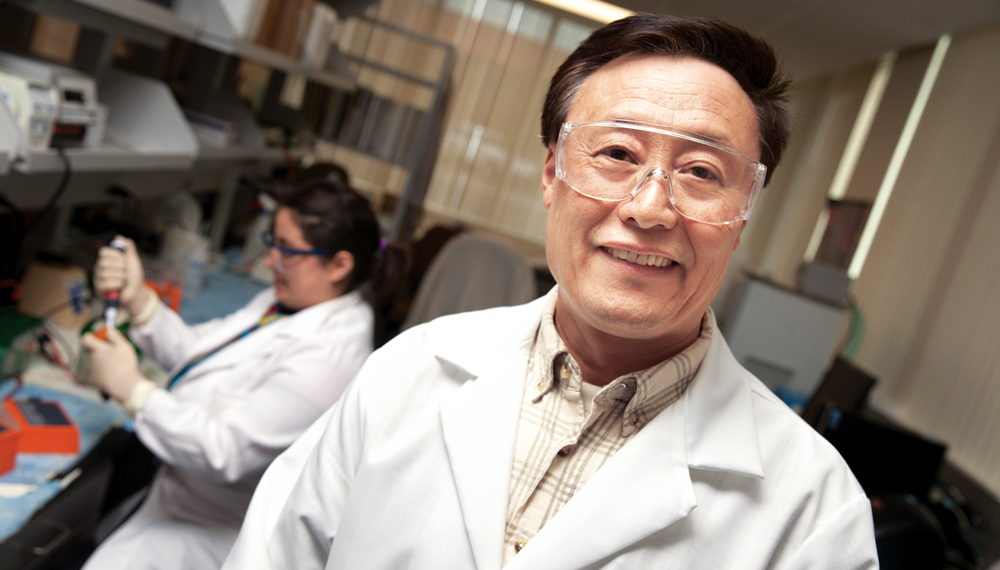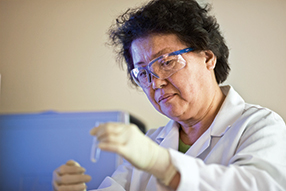
Breast cancer trailblazing
Stem cell discovery broadens treatment options
Tumors contain many parts, including healthy tissue and malignant cells with different mutations. This underlying chaos is one of the reasons cancer can be so difficult to treat. Even if the primary tumor is eradicated, smaller cell groups with different, sometimes treatment-resistant, mutations can bring it back.
Fortunately, researchers are beginning to get a handle on this chaos. Over the past few years, they have identified different tumor subgroups, recognized how they affect disease progression and, in some cases, developed treatments to combat them. They’ve learned that cancer is a highly personalized disease — tumors in the same types of tissue can differ substantially from patient to patient.
HER2-negative?
One success story is HER2, a cell surface protein that is overproduced in some breast cancers. A cancer’s HER2 status can have a significant impact on the tumor’s aggressiveness, as well as patients’ overall prognosis and their treatment choices. HER2-positive breast cancers are routinely treated with Herceptin or Tykerb, antibody drugs that inhibit the protein, with good results. However, until recently, there has been little reason to administer these targeted treatments to patients with HER2-negative cancer.
But that could change. A nationwide study led by UC Davis Comprehensive Cancer Center researchers found that HER2-negative tumors can contain a small, stubborn group of HER2-positive breast cancer stem cells (BCSCs). Prior to this research, most experts believed that a breast cancer was either HER2 positive or negative — but never both. This finding underlines the chaotic environment in breast tumors and may change how these cancers are treated.
“These BCSCs are very resistant to traditional treatments, which can lead patients to relapse,” says Jian-Jian Li, a professor in the Department of Radiation Oncology and the cancer center’s director of translational research. “Despite chemotherapy, radiotherapy or even surgery, the cancer is still recurrent. These findings modify our concept of breast cancer, because now we believe HER2-negative breast cancers can be treated effectively with anti-HER2 treatments.”
Hunting cancer stem cells
Regardless of where they come from, stem cells are recognized by their ability to divide, like fully mature cells, and differentiate into more mature cell types. While embryonic stem cells are known for their ability to become virtually any cell type, the body contains more specialized adult, or somatic, stem cells, which can regenerate brain, muscle and other tissue.
In recent years, biologists have hypothesized that some cancers may contain their own version of stem cells that are highly resistant to treatment and can therefore differentiate into new tumor cells. If the main tumor is destroyed by radiation, chemotherapy or surgery, the cancer stem cells can step in to generate a new tumor.
“We think there’s a subpopulation of cells that has fundamentally different properties than the rest of the tumor,” says Wolf-Dietrich Heyer, chair of Microbiology and Molecular Genetics. “These cells are dormant and very resistant to treatment because they divide so slowly and may be responsible for recurrent cancer.”
A needle in a haystack
The new study is providing ample evidence to back up this hypothesis. The starting point was a well-studied line of breast cancer cells known to be resistant to radiation. The team wanted to figure out why that cell line is so radiation-resistant and whether a smaller subgroup of BCSCs was giving it those properties.
The group, which included researchers from the University of Michigan, University of Iowa, Emory University and MD Anderson Cancer Center, painstakingly isolated the cells they suspected were BCSCs. They were looking for cells that expressed the breast cancer stem cell markers CD44 and CD24. They found that cells that were CD44 positive and CD24 negative were more aggressive and particularly resistant to radiation. However, these cells also responded to Herceptin and other treatments.
In addition to identifying this previously hidden group of HER2-positive stem cells, the team also looked at how these BCSCs maintain their treatment resistance. They identified a complex group of proteins that control metastasis, programmed cell death and other functions. In particular, the power to inhibit cell death is a big deal, giving these tumors the ability to survive the gamut of traditional anti-cancer therapies.
“This research provides breast cancer patients with new information, especially for patients whose tumors are HER2-negative,” says Li. “Patients could get second opinions or they could have their HER2 status rechecked after treatment. If the tumor does become HER2-positive, other treatments could be prescribed.”
Improving diagnosis and treatment
While this research may open up new treatment options for HER2-negative cancer, it also outlines a new approach to diagnose HER2-positive BCSCs in patients. Markers like CD44 could help clinicians identify these aggressive cells in cancers that appear to be HER2-negative, personalizing treatment to match each patient’s needs. These findings may also advance treatment for other cancers.
“This may open the possibility of treating HER2-positive stem cells in bone, lung or brain cancers, which are all difficult to treat in the later stages,” says Li.
Also, by isolating this group of treatment-resistant cells in breast cancer, the team blazes a trail for scientists to pursue similar research in other stubborn cancers. And while those studies are in the future, the results of this study could potentially influence clinical care today.
“This study has direct implications for the clinic,” says Heyer. “Even if a cancer is HER2-negative, HER2 therapy might be helpful. Ultimately, we may begin treating cancers the way we currently treat HIV — by using a concurrent cocktail of therapies.”

